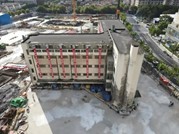It didn’t happen all that often, but every once in a while, when I was growing up, there’d be something in the news about a house being moved from one location to another. As I recall, it was usually an old farmhouse in the path of development, and the owners wanted to keep their home’s good bones and old-fashioned charm. The house would be lifted off of its foundations, placed on an ultra-wide flat bed, and slowly – very slowly – transported to its new resting place, where a newly poured foundation was awaiting it.
As a kid, I was intrigued by the process, but I haven’t given it a lot of thought since.
Then I happened upon a story about an 85-year-old school in Shanghai that was moved to make way for commercial space. The government wanted to preserve the structure because of its historic nature, and will be using it as a preservation and cultural center.
Unlike the buildings I heard about back in the day, the school building was pretty large – five stories, weighing in at 7,600 tons – and had an unusual t-shape. Obviously, this building was too large, and too awkward, to get slid onto a flatbed and carrying to its new home. Putting the structure on rails and sliding it along – another method for conveying a building from Point A to Point B – would likely have failed, as the structure would not have been able to tolerate the lateral forces need to move it along.
So, enter the “walking machine”. To move the building:
…engineers attached nearly 200 mobile supports under the five-story building, according to Lan Wuji, chief technical supervisor of the project.
The supports act like robotic legs. They’re split into two groups which alternately rise up and down, imitating the human stride. Attached sensors help control how the building moves forward, said Lan, whose company Shanghai Evolution Shift developed the new technology in 2018.
“It’s like giving the building crutches so it can stand up and then walk,” he said. (Source: CNN)
It took over two weeks to move the building (which in addition to being moved had to be rotated 21 degrees as well) a total of 203 feet.
“During my 23 years of working in this area, I haven’t seen any other company that can move structures in a curve,” [Lan] added.
Watching the building go for a walk is fascinating. (Here’s the link to YouTube.) I’ve had a long interest in robotics, and have gotten a real kick out of applications like Spot, the robotic dog from Boston Dynamics, which I wrote about earlier this year. I would have been happy as a kid just to see a tiny little farmhouse getting moved on a flatbed truck. I would have been over the moon to see this good-sized school building walking. The technology was developed by engineers at Shanghai-based Evolution Shift. Hats off to the Evolution Shift team. That’s quite an engineering feat!
